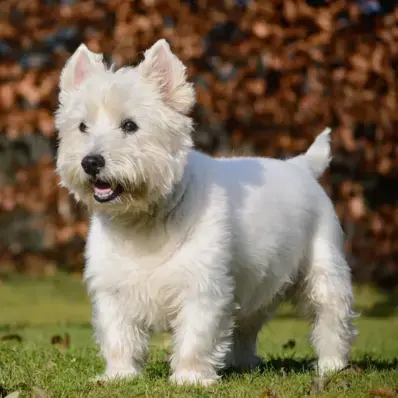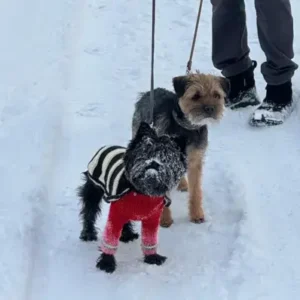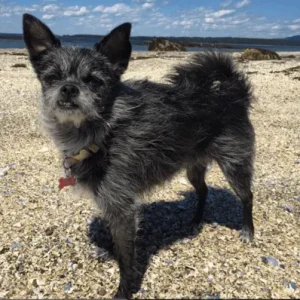West Highland White Terrier Origin
The West Highland White Terrier shares its history with the Dandie Dinmont, Skye, Cairn Terriers, and Scottish Terriers, all considered branches of the same dog breed. Originating in Scotland, Westies were used for hunting foxes, badgers, otters, and vermin-like rats.
The exact history of the West Highland White Terrier is unclear, but it’s believed to date back to the seventeenth century when James I of Argyllshire gifted a small breed of earth dogs to the king of France.
Breed lore suggests that Westie’s white color resulted from a tragic nineteenth-century accident. Colonel Edward Donald Malcolm of Poltalloch accidentally shot one of his wheaten-colored Cairns while hunting foxes. Devastated by the incident, he decided to breed only white dogs to prevent such accidents in the future.
West Highland White Terrier History- Source: AKC.org
The West Highland White Terrier has been known by many names, including the Poltalloch Terrier and the Roseneath Terrier. The breed was officially recognized by the Kennel Club of England as the West Highland White Terrier in 1906. The breed was recognized by the American Kennel Club under Terrier Group in 1906.
West Highland White Terrier Personality
The West Highland White Terrier, or Westie, is a bold, confident, and fun-loving dog. These purebred dogs find joy in simple pleasures like squeaky toys, belly rubs, and food. Their happy disposition and zest for life make them favorites for many, despite their mischievous nature. They are intelligent and full of self-esteem, but not to the point of being overbearing.
- Temperament
Westies are friendly and get along well with everyone. They enjoy being part of their family and are not docile lapdogs. They can be spunky and lively, greeting life’s adventures with a sparkle in their eyes and a skip in their step. While they rarely start fights, they won’t back down from one, being true terriers.
- Potential Challenges
West Highland White Terriers are known for their lively and independent nature. They can be quite a handful when it comes to training. Consistent and firm guidance is often required to curb their stubborn streak. Their high energy levels mean they need regular exercise and mental stimulation, otherwise, they might resort to digging and barking out of boredom.
West Highland White Terrier Physical Appearance
The sturdy and spirited “Westie” showcases a compact, well-balanced build with solid substance, featuring a short-coupled frame and strong bones. Known for its robust nature, this small dog has a deep chest and a slightly rectangular body shape.
- Size
Males typically stand around 11 inches tall and weigh between 15 to 20 pounds, while females are approximately 10 inches tall and weigh 13 to 16 pounds.
- Coat color
Westies possess a White double coat consisting of a short undercoat and a topcoat that can grow close to two inches in length. This dual-layered coat protects against harsh weather conditions and also shields them from the teeth and claws of their prey.
White Westie – Source: AKC.org
West Highland White Terrier Gender Differences
The primary differences within this breed are based on size and temperament. Male Westies are known for their playful, independent, and relaxed nature. They tend to be slightly larger and more energetic compared to females.
Female Westies enjoy being the center of attention and may bark to ensure they are noticed. They exhibit all the lovable traits of the breed but often see themselves as leaders within their household.
West Highland White Terrier Feed/Nutrition
Adult Westies typically require 1/2 to 1.5 cups of high-quality dry food per day, split into two meals. The amount your dog needs depends on factors like size, age, metabolism, and activity level.
Just like people, dogs are individuals with varying nutritional needs. Active dogs will likely need more food than less active ones. Choosing high-quality dog food ensures your dog receives better nutrition, requiring less quantity to satisfy their dietary needs.
Broccoli is a healthy snack for dogs in moderation, but too much can cause stomach upset.
West Highland White Terrier Health
Westies are generally healthy, but like all breeds, they are prone to certain health problems. Not every Westie will develop these common conditions, but it’s important to be aware of them if you’re considering this breed. When purchasing a puppy, seek out a reputable breeder who provides health clearances for both parents. These clearances confirm that the dog has been tested and cleared of specific conditions.
- Craniomandibular Osteopathy: This condition affects skull bone growth in puppies, causing irregular enlargement. Symptoms typically appear between four to eight months of age and may include swollen jaw and glands, difficulty opening the mouth, drooling, and recurring fever. While there is no cure, management with anti-inflammatories and pain relievers can help alleviate discomfort. In severe cases, nutritional support and sometimes jaw surgery may be necessary.
- Legg-Calve-Perthes Disease: This condition involves decreased blood supply to the femur’s head, leading to disintegration and symptoms like limping and muscle atrophy in puppies aged four to six months. Surgical intervention can often resolve the issue, providing relief from pain.
- Cataracts: A common eye condition in Westies, cataracts cause opacity on the lens, resulting in impaired vision and a cloudy appearance in the eye(s). Surgery may be an option to improve vision, especially in juvenile cases.
- Pulmonary Fibrosis: This disease causes scarring in the lung’s air sacs and connective tissue, reducing oxygen flow and leading to symptoms such as loss of stamina, rapid breathing, and a dry cough. While there is no cure, early detection and management strategies like bronchodilators and maintaining a cool environment can help manage symptoms and improve outcomes.
- Patellar Luxation: Commonly known as slipped stifles, this condition involves the kneecap sliding out of place, causing pain and potentially hindering movement. Many dogs can live normally with this condition, although severe cases may require surgical correction.
West Highland White Terrier Care and Grooming
The Westie’s coat is low-maintenance, needing regular brushing and occasional trimming, especially around the feet, ears, and eyes. Show dogs undergo stripping twice a year, but most pet owners opt for simpler grooming routines. Their shedding is minimal to nonexistent.
To maintain their signature white coat, periodic tidying and wiping down are necessary. Baths should only be given as needed to keep their coat clean.
Westies are energetic dogs that need regular exercise to stay healthy and happy. Daily walks of 30 to 60 minutes are ideal, along with interactive play sessions like fetch or agility training.
Mental challenges, such as puzzle toys or training exercises, can also keep them engaged. Regular exercise helps prevent boredom, promotes good behavior, and maintains their overall fitness.
Leash training your dog is essential for safe walks and better control. Start with short, positive sessions, rewarding good behavior to build a strong foundation.
West Highland White Terrier Rescue Groups
Rescuing a West Highland White Terrier offers a chance to provide a loving home to a dog in need. Many rescued Westies are beloved pets seeking new families due to unforeseen circumstances. Adopting a rescued Westie means gaining a loyal and affectionate companion while giving them a second chance at a happy life.
West Highland White Terrier Price
The price of a West Highland White Terrier typically ranges from $1,500 to $5,000, depending on factors such as breeder reputation, pedigree, and location.
When considering purchasing a West Highland White Terrier, it’s important to find a reputable breeder who prioritizes the health and well-being of their dogs. Responsible breeders will provide health clearances and ensure proper socialization of the puppies.
Interesting Facts
- They have appeared in The Dog Breed Judging Show 2023.
- They have starred in a movie called “ Game Night”.
Game Night- Source: Vulture
Best For
The West Highland White Terrier (Westie) is perfect for those who want a small, sturdy, and playful companion. They are intelligent, easy to train, and thrive in homes where they receive moderate exercise and regular grooming to maintain their distinctive coat. Their loyalty and compatibility with children and other pets make them excellent family pets.
Top Names
| Male West Highland White Terrier Names | Female West Highland White Terrier Names |
| Max | Daisy |
| Charlie | Lucy |
| Buddy | Bella |
| Toby | Molly |
| Teddy | Lily |









 West Highland White Terrier History- Source:
West Highland White Terrier History- Source: 

 White Westie – Source:
White Westie – Source: 
 Game Night- Source:
Game Night- Source: 






